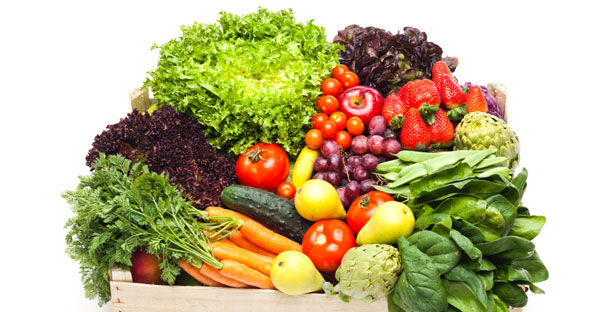

Crispy, crunchy, colorful, and curiously delicious — all are words that describe a wide variety of vegetable, fruit, and whole-grain dishes. Research supports eating a variety of plant-based foods to promote health, but most people do not get enough of these nutrient-dense foods. Most plant-based foods are naturally low in calories and fat, but have high amounts of antioxidants and other healthful phytochemicals, as well as fiber.
The abundant food supply in the United States provides almost 500 calories per person beyond what the average adult needs each day for growth, maintenance, and physical activity, according to 2008 estimates from the U.S. Department of Agriculture. The estimated number of calories needed by the average adult is 2,200 each day. The excessive number of calories available in the United States, compared to those needed, helps explain why the number of overweight children and overweight and obese adults is increasing.
The Dietary Guidelines for Americans encourages increased consumption of plants — whole grains, fruits, vegetables, legumes, nuts, and seeds — and reduced consumption of solid and added fats, added sugars, and refined grains. However, people are not eating nearly as much plant food as is recommended. Data from 2008 show that, on average, people consume about half the recommended amount of fruits and vegetables daily.
On the other hand, many people over-consume added sugars, getting around three times the amount recommended by the American Heart Association’s guidelines of 6 to 9 teaspoons per day.
Don’t let a busy schedule keep you from choosing healthful foods. Instead, turn to a diet with more plants, one that is full of flavor and nutrients, low in calories, and very satisfying.
Benefits of Consuming More Plants
Weight control
Weight gain is generally correlated with high daily calorie intake, and eating a small amount of nutrient-dense foods full of dietary fiber and complex carbohydrates. Fruits, vegetables, legumes, and whole-grain foods typically provide a feeling of fullness with fewer calories, compared to other types of foods. Putting more of these kinds of plants on the plate makes it easier to manage appetite and maintain body weight.
High dietary fiber
Only plant foods contain fiber. Dietary fiber is a complex form of carbohydrate. Several decades of studies have confirmed the health benefits of eating a fiber-rich diet. Specifically, diets rich in foods containing fiber — such as fruits, vegetables, and whole grains — may reduce the risk of coronary heart disease and improve regularity. A healthy elimination system allows bodies to get rid of toxins. Beans and legumes contain more dietary fiber than almost any other food, so they are an integral and versatile part of a balanced diet. The dietary fiber in legumes is both soluble — which is especially useful in helping control cholesterol levels to lower heart disease risk — and insoluble — which improves regularity. Beans are also filling, so they help promote weight management by satisfying hunger.
Chronic disease management
Consuming a diet featuring more plants is good for your health —today and tomorrow. Complex carbohydrates are easy to digest, and the antioxidants in plants help strengthen your body’s immune system. Dramatic results have occurred with the adoption of a more plant-based diet. Many people with heart disease, diabetes, cancer, and various autoimmune diseases have been able to alleviate their symptoms by eating more whole grains, fruits, vegetables, legumes, nuts, and seeds, and consuming fewer solid and added fats, added sugars, and refined grains.
Plant-Based Diet Q&A
Q: Will I be able to get enough protein if I eat a more plant- based diet?
A: A wide variety of plant-based foods provide protein. (See table below right.) Most Americans would benefit from eating more legumes, whole grains, nuts, and seeds, and eating fewer protein-rich foods containing saturated fats or added fats. A common misconception about dietary protein is that large amounts of it are needed for good health. The Institute of Medicine recommends 40 to 70 grams of protein each day, based on gender, age, body weight, and activity level. Almost everyone in the United States (except for some older adults) consumes enough protein, with most averaging about 75 grams per day.
Q: Won’t eating carbohydrates found in plant foods make me fat?
A: A diet rich in complex carbohydrates — such as fruits, vegetables, and grains prepared with minimal processing — is not “fattening.”
Good Sources of Plant Protein
| Food | Serving Size | Amount of Protein |
|---|---|---|
| Lentils, cooked | 1 cup | 18gm |
| Black beans, cooked | 1 cup | 15gm |
| Kidney beans, cooked | 1 cup | 13 gm |
| Pinto beans, cooked | 1 cup | 12 gm |
| Black-eyed peas, cooked | 1 cup | 11 gm |
| Tofu, firm | 4 ounces | 11 gm |
| Quinoa, cooked | 1 cup | 9 gm |
| Bagel | 1 medium | 9 gm |
| Peanut butter | 2 tbsp. | 8 gm |
| Brown rice pasta, cooked | 1 cup | 8 gm |
| Almonds | 1/4 cup | 8 gm |
| Soy milk | 1 cup | 7 gm |
| Sunflower seeds | 1/4 cup | 6 gm |
| Whole wheat bread | 2 slices | 5 gm |
| Brown rice, cooked | 1 cup | 5 gm |
| Spinach, cooked | 1 cup | 5 gm |
Rather, the overconsumption of refined carbohydrates, added sugars, and fats has contributed to excess weight problems. For example, 1 cup of mashed potatoes contains 130 calories. Add 1 tablespoon of butter and you have added 100 calories. But the calories from the butter do not fill you up, because they do not add bulk to the food. The key to eating well, being full, and being fully nourished is to eat foods low in calories, high in nutrient density, and high in fiber to provide the feeling of fullness. These are complex carbohydrate foods.
Q: My kids hate vegetables. If we try this, won’t I be throwing away a lot of food?
A: Do your kids really hate vegetables or have you given them a chance to love them? In the curriculum Food is Elementary, by Dr. Antonia Demas, students are allowed to first smell the food and then slowly taste new whole foods. When children are involved in selecting and preparing vegetables, they are more likely to eat them. For example a fun experiment is to have children guess what color the cooking water will be after you cook purple cabbage. Most will guess purple or pink when it is actually aquamarine. Try preparing vegetables in a variety of ways — from raw, to lightly steamed, to stir-fried. Children are like sponges soaking up information, so make sure they see you enjoying your veggies.
Q: How does an athlete perform when eating more plants?
A: Athletes pay a lot of attention to their nutritional needs. They want to get the most out of their bodies and realize what they eat makes a difference. Tony Gonzales, an all-star National Football League player, shares his story in his book, The All-Pro Diet, co-authored with his nutritionist, Mitzi Dulan. In his eleventh year of playing football he switched to a more plant-based diet. Health issues motivated Gonzales to adopt an eating plan that emphasized fruits, vegetables, legumes, whole grains, and nuts. Today he also includes fish, eggs, chicken, and an occasional portion of lean beef. Not only did his health improve but his performance on the football field improved as well. Other elite athletes who have performed well on plant-based diets include Carl Lewis, who has won eight Olympic gold medals; tennis champion Martina Navratilova; and Dave Scott, a multi- winner of the Ironman Triathlon in Hawaii. A diet rich in protein- dense plant-based foods can meet the nutritional needs for an athlete at any level.
Q: It looks like eating a more plant-based diet means cooking from scratch. I don’t have enough time.
A: Preparing some grains and legumes takes planning, but most are easy to prepare. Beans or grains can be soaked overnight and cooked while getting ready for work in the morning, or cooked for the next day during your evening meal. With those items already cooked, a plant-based meal can go together quickly. And don’t forget that many vegetables and virtually all fruits can be eaten raw.
Q: I don’t have a large budget for groceries. How can I afford to buy more grains and fresh produce?
A: Pound for pound, fresh produce and grains are less expensive than meat, packaged convenience foods, and most foods with added fats and sugars. The health benefits are great, so you may save on medical expenses. Another tip for saving money on groceries is to purchase fresh produce that is in season and grown locally when possible. Other economical options include frozen and canned vegetables.
Conclusion
Where to go from here
Adopting a more plant-based diet requires a change in thinking. As research in nutrition has advanced, it has become apparent that the typical American plate includes too much animal protein — and the saturated fat that comes with it — and too little plant-based food. As a result, Americans are consuming too many calories, too much fat, and not enough of the nutrients that keep people healthy in the long term.
It is not easy to change eating habits. But gradually, as more vegetables, fruits, grains, and legumes are added to your daily menu, you will discover or rediscover how “real food” looks, smells, and tastes. Savor each bite for all of the benefits you gain from eating the whole foods found in a more plant-based diet.
Reviewers
Mary Meck Higgins, Ph.D., Nutrition Specialist, K-State Research and Extension, and Associate Professor, Human Studies and Family Services, Kansas State University
Ginny Barnard, Family and Consumer Sciences Agent, K-State Research and Extension – Riley County
References
- American Heart Association, “Dietary Sugars Intake and Cardiovascular Health,” Circulation 2009;120:1011- 1020.
- Campbell, T. Colin, Ph.D. and Campbell, Thomas, 2005. The China Study, Dallas, Texas: BenBella Books.
- Collins, Karen, MS, RD, CDN, American Institute for Cancer Research, 2009. Nutrition Wise Newsletter, October 19, 2009.
- Demas, Antonia, Ph.D., 2009. Nutrition in the Public School System, lecture transcript.
- Duyff, Roberta Larson, MS.RD, FADA, CFCS, 2006. Complete Food and Nutrition Guide, 3rd edition, pages 226-227, 241-242, 505-522, Hoboken, NJ: Wiley
- Food and Nutrition Board, Institute of Medicine of the National Academies, 2005. Dietary Reference Intakes for Energy, Carbohydrate, Fiber, Fat, Fatty Acids, Cholesterol, Protein, and Amino Acids (Macronutrients). The National Academies Press, Washington, D.C. Online at http://books.nap.edu/catalog.php?record_id=10490 (Accessed January 24, 2011)
- Gonzalez, Tony, with Dulan, Mitzi, R.D., 2009. The All- Pro Diet. New York: Rodale Books.
- USHHS and USDA, 2011. Dietary Guidelines for Americans, online at: www.health.gov/dietaryguidelines (Accessed January 24, 2011)
- USDA Economic Research Service, Food Availability (Per Capita) Data System, online at: www.ers.usda.gov/Data/FoodConsumption (Accessed January 24, 2011)
- USDA, 2005. Composition of Foods, Nutrient Data base for standard reference, www.ars.usda.gov/main/site_main.htm?modecode=12-35-45-00.
Recipe Resources
- American Institute for Cancer Research, 2005. The New American Plate Cookbook, University of California Press.
- O’Connor, Nancy, Rolling Prairie Cookbook, 1998. Spring Wheat Nutrition Education Services, Lawrence, KS 66046.
Copyright 2024 Center for Nutrition Studies. All rights reserved.
Earn Your Plant-Based Nutrition Certificate
Join over 20,000 students who have improved their health, learned new skills, and even inspired career changes.
Program Overview
- 23,000+ students
- 100% online, learn at your own pace
- No prerequisites
- Continuing education credits










